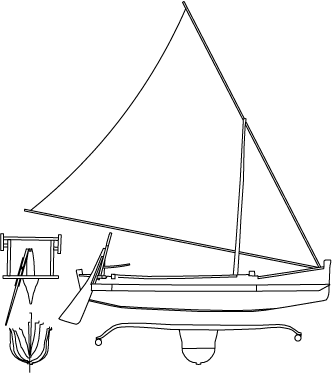
Traditional Indonesian Trimaran
 |
A Jukung from Madura Island Traditional Indonesian Trimaran |
Click on any picture for a big version in a new window.
The canoe on the beach at Slopeng on the north shore of Madura. Slopeng is the
name in Bahasa Madura, the local language, but some maps call it Salompeng.
The little hut and rainwater catchment next to the canoe. The canoe doesn't
appear to have moved in a year or two.
Details of the canoe's construction.
The lines. Strange photos like this and some measurements are what I need to
draw the sections.
As described in the book "Clean Sweet Wind". Michelle Brown does the
honors. If you designed this canoe or are an heir or trustee let me know what
sort of licensing fee is customary.
Here are the drawings.
 This
directory contains the rhino 3.0 cad file and various 2d versions.
This
directory contains the rhino 3.0 cad file and various 2d versions.
The sail is a best guess based on the spars present.
The rudder is a best guess based on nearby boats and boats in museums.
The rudder hangs from the forked post by a braided ring of rope or rattan that
encircles the top of the rudder shaft.
Another rope and stick hold it against the lower bracket. See the Lepalepa page
for a similar arrangement.
I measured only one ama, I see now that the other is a couple feet longer and
protrudes in front beyond the hull.
This is a very fat canoe. It would carry a lot.
The waterline beam-to-length ratio of 7:1 should have wavemaking drag at speeds
greater than 5.8 knots.
A western designer would go no wider than 9:1.
Horridge photographed a similar canoe here in the 80's. He says the sailrest
is from Sulawesi and the rudder post is
Javanese. See pp.109, 111 of his book "Outrigger Canoes of Bali and Madura".
The book shows other very large
canoes here, and the beach is famous on Madura for Jukung.Where have they gone?
It's blowing whitecaps and there are no sails in sight. The beach is deserted
for miles.
An old man with severe stroke symptoms is the only person who passed in three
hours.
I gave him a jillion Rupiah (one dollar) but that was as much communication
as we could manage.
A real anthropologist would hunt down some locals and actually find out the
canoe's story.
At the time I just wanted to try out this method of shooting the sections and
was expecting to see many other
canoes. This turned out to be the biggest and best preserved canoe we saw on
our trip around Madura, so
I went ahead and made drawings. If you know where the other canoes are hiding,
let me know.
There are a few tiny canoes parked nearby in various stages of decay.
The round palmetto leaf in the pictures is two feet across for scale.
We walked a few miles down the beach til we came to this nice mosque. A few
more tiny canoes are pulled up around it,
slowly returning their molecules to the universe. Some friendly guys (the only
kind on Madura) sleeping on the porch wake
up enough to greet us.
An interesting raft made of pvc pipe.
Another rainwater pool. I wonder if saltwater is allowed for washing before
prayers.
Maybe local boat fashion has turned to monohulls? These pretty Perahu have a
Norse sort of shape.
We catch a minibus west. The first river we come to is full of colorful boats.
Engines seem to have replaced the sails, but not the spectacular decorations.
A
wheelbarrow with welded spokes made from reinforcing rod.
The rakish local rickshaws, called "Becak". Pronounced "bay-chock".
Time to replenish the old electrolytes with nature's perfect drink.
c.Tim Anderson 2004